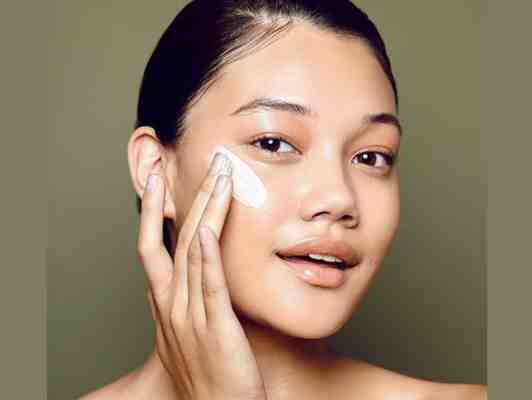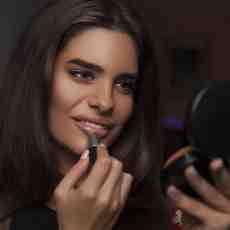What is Makeup Made From?
Today’s Wonder of the Day was inspired by laila. laila Wonders, “ What is makeup made of? ” Thanks for WONDERing with us, laila!
Have you ever spread ash across your eyelids? How about beeswax on your fingernails? Have you ever helped someone put white lead on their face? How about berry juice on their cheeks?
No? Okay, those aren’t common practices today. But many centuries ago, people used these and many more ingredients as makeup.
The earliest known users of makeup were the ancient Egyptians. They used many plants and minerals as makeup. Some of the most common ingredients were almonds, copper, lead, and ash. They also used oils to protect their skin from the Sun.
Later, people in China and Japan used rice powder as makeup. They also used henna dyes in their hair, as many people still do today. Chinese people also painted their fingernails. Their differently colored nails marked their social class.
In ancient Greece, women used white lead paint on their faces. They were also the first to use crushed berries to color their cheeks. Some people in Greece also wore fake eyebrows made of oxen hair.
Makeup has changed over the centuries. Today, people who use makeup may not know everything that’s in it. However, makeup companies do have to follow rules about the ingredients they use. In the United States, the Food and Drug Administration (FDA) has to approve all makeup ingredients.
So, what IS modern makeup made from? Most products have between 15 and 50 ingredients. Almost all of them have water, oil, and wax. The water dissolves other ingredients. This helps them mix together. Oil and wax help makeup go on smoothly. They’re both also often used to help skin stay soft.
Many other chemicals go into makeup. Normally, an emulsifier is included. That’s a chemical that makes oil and water mix. Most makeup also has preservatives. Just like in food, these keep the makeup usable longer. There are many chemicals that can do either of these jobs. Since people react to chemicals differently, many have to be careful about which products they buy.
Of course, most types of makeup also have a coloring agent. Have you ever seen pink, red, or purple lipstick? How about blue or green eyeshadow? Any makeup with a color contains a coloring agent. These come from minerals, plants, and even animals.
Today, many people are paying closer attention to what goes in makeup. Some buy “all-natural” makeup. That means it isn’t made from artificial ingredients. Others are turning to vegan makeup. To be vegan, it can’t use anything that comes from animals.
Okay, so makeup can be made of many different things. How do you know what’s in each bottle? Your best bet is to read the label. If you see anything in the ingredients list that you’re not sure about, learn more about it.
Have you ever used makeup? Are there any ingredients that you look for? What about the ones you avoid? Makeup ingredients affect everyone differently. You should always be careful about what you put on your skin!
What Is Makeup Primer and Do I Need It?
The best natural products use botanical ingredients instead of potentially toxic chemicals to prep and nourish your skin. Here are a few of our favorites for color-correcting, enhancing eye makeup, and for daily wear.

Vapour Beauty Essential Daily Primer
For a lightweight facial primer that hits all the marks, there’s Vapour Beauty’s daily primer. It enhances makeup application using nourishing macadamia and jojoba oils, cranberry water to clarify, and ginger water for an even skin tone and improved elasticity.
The best part? You just smooth it on with your fingertips — no tools needed.
Grove member Samantha K. says about this product, “I love, love, love this primer. It seems to keep my makeup in place and even last through days when I have to keep my mask on.”
PYT Beauty Baby Got Base Eye Primer
PYT Beauty’s eye primer is a sheer nude cream made with antioxidant-rich pomegranate extract, calming green tea, and moisturizing ginseng. It preps your lids to extend the wear of your eyeshadow without creasing, caking, or fading and works on a wide range of skin tones.
Plus it comes in a cute cherry red tube that’ll look great on your vanity.
Alima Pure Color Balancing Primer Powder
This vegan primer powder by Alima Pure is made from just two ingredients: mica powder and mineral pigment. It’s ideal for days when you don’t feel like wearing a full face of makeup but still want light coverage.
It works wonders for reducing redness caused by skin sensitivities, sunburn, and rosacea because of a green-based pigment that counters discoloration.
Grove member Molly B. wrote “I love this neutral tone powder as it is super fine and blends into your pores perfectly without having any dangerous chemicals or irritants in it. it is perfect for blending on the forehead and over highlighted and lighter areas, under the eyes, as well as your whole face. Keeper!”
Need a brush for your powder? Check out our top ten makeup brushes, and treat yourself to a fresh set!
MedlinePlus
Summary

Cosmetics are products you apply to your body to clean it, make it more attractive, or change the way it looks. They include:
Hair dyes
Makeup
Perfumes
Skin-care creams
Cosmetics that treat or prevent diseases are also drugs. Products such as dandruff shampoo, fluoride toothpaste, and antiperspirant deodorant are both cosmetics and drugs. A good way to tell if you're buying a cosmetic that is also a drug is to see if the first ingredient listed is an "active ingredient." The active ingredient is the chemical that makes the product effective. The manufacturer must have proof that it's safe for its intended use.
Cosmetics can cause allergic reactions. The first sign is often red and irritated skin. Fragrances and preservatives are the most common causes of skin problems.
To find out all the ingredients in a cosmetic you use, check the container. Manufacturers are required to list them. Labels such as "natural" and "hypoallergenic" have no official meaning. Companies can use them to mean whatever they want.
Food and Drug Administration
